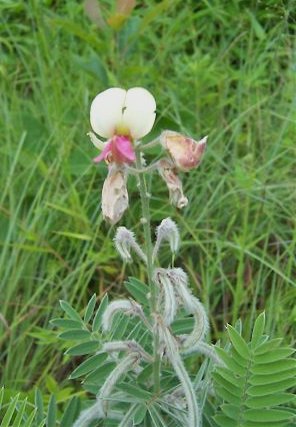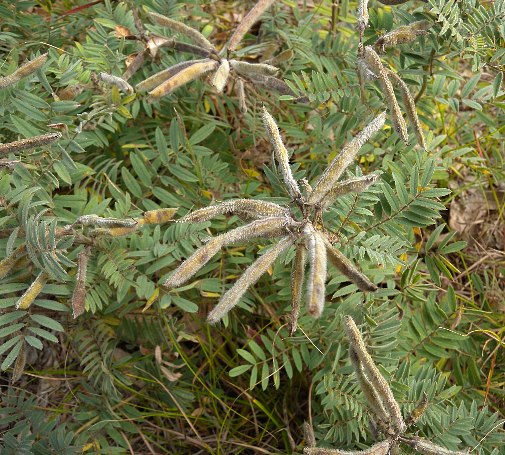 Description:
This
perennial wildflower is 1-2' tall, sending up one or more stems from
the base that are unbranched or sparingly branched. The stems are light
green, terete, and hairy. Alternate compound leaves are widely
spreading; they are odd-pinnate with 9-25 leaflets. Individual leaflets
are up to 1" long and ¼" across; they are medium green to grayish
green, oblong to narrowly elliptic in shape, and
smooth along
their margins. Upper surfaces of the leaflets are hairless to
silky-hairy, while their lower surfaces are pubescent to silky-hairy.
Each leaflet has a prominent central vein. The central stalk (rachis)
and petiole of each compound leaf is pubescent. At the base of each
petiole, there is a pair of small stipules about ¼" long. The stems
terminate in short dense racemes about 2-3" long that are covered in
buds and bicolored flowers facing all directions. The racemes are held
a little above the foliage on short peduncles. Individual flowers are
¾" long and across, consisting of 5 petals, a short tubular calyx with
5 teeth, 10 stamens, and a pistil. Each flower has a typical pea-like
floral structure, consisting of an upright banner and a pair of lateral
wings that project forward to enclose the keel. The broad banner is
white to pale greenish yellow, while the wings are deep rosy pink. The
pedicels of the flowers and their calyces are light green and
pubescent. The blooming period occurs from early to mid-summer and
lasts about 3 weeks. Afterwards, the flowers are replaced by widely
spreading seedpods about 1½-3" long. These seedpods are initially light
green, but later turn brown; they are silky-hairy. The seedpods are
narrowly cylindrical and slightly flattened in shape; each pod contains
several seeds that are reniform and somewhat flattened. The root system
consists of a deep taproot.
Description:
This
perennial wildflower is 1-2' tall, sending up one or more stems from
the base that are unbranched or sparingly branched. The stems are light
green, terete, and hairy. Alternate compound leaves are widely
spreading; they are odd-pinnate with 9-25 leaflets. Individual leaflets
are up to 1" long and ¼" across; they are medium green to grayish
green, oblong to narrowly elliptic in shape, and
smooth along
their margins. Upper surfaces of the leaflets are hairless to
silky-hairy, while their lower surfaces are pubescent to silky-hairy.
Each leaflet has a prominent central vein. The central stalk (rachis)
and petiole of each compound leaf is pubescent. At the base of each
petiole, there is a pair of small stipules about ¼" long. The stems
terminate in short dense racemes about 2-3" long that are covered in
buds and bicolored flowers facing all directions. The racemes are held
a little above the foliage on short peduncles. Individual flowers are
¾" long and across, consisting of 5 petals, a short tubular calyx with
5 teeth, 10 stamens, and a pistil. Each flower has a typical pea-like
floral structure, consisting of an upright banner and a pair of lateral
wings that project forward to enclose the keel. The broad banner is
white to pale greenish yellow, while the wings are deep rosy pink. The
pedicels of the flowers and their calyces are light green and
pubescent. The blooming period occurs from early to mid-summer and
lasts about 3 weeks. Afterwards, the flowers are replaced by widely
spreading seedpods about 1½-3" long. These seedpods are initially light
green, but later turn brown; they are silky-hairy. The seedpods are
narrowly cylindrical and slightly flattened in shape; each pod contains
several seeds that are reniform and somewhat flattened. The root system
consists of a deep taproot.
Cultivation:
The preference is full or partial sun, mesic to dry conditions, and an
acidic sandy soil. Goat's Rue adds nitrogen to the soil.
Range & Habitat:
The native Goat's Rue is occasional in all areas of Illinois, except
the
east-central section, where it is absent (see Distribution
Map). Habitats include upland sand prairies, sandy hill
prairies, sand dunes, upland sandy savannas, upland rocky savannas, and
sandstone glades. In more wooded areas, Goat's Rue typically occurs
where oaks are the dominant trees.
Faunal Associations:
The nectar and pollen of the flowers attract leaf-cutting bees (Megachile
spp., Hoplitis spp.) and possibly other
long-tongued bees. The caterpillars of the skipper, Thorybes
bathyllus (Southern Cloudywing), feed on the foliage of
Goat's Rue and other species in the Bean family. Other insect feeders
include caterpillars of the moth Semiothisa eremiata
(Three-lined Angle), seed-eating larvae of two straight-snouted weevils
(Apion
segnipes, Apion perforicolle), the plant
bug Teleorhinus tephrosicola, the blister beetle Epicauta
murina, and several leaf beetles (Bassareus lituratus,
Odontota horni, Odontota notata,
Pachybrachis othonus, Phyllecthris
gentilis). Among vertebrate animals, the seeds are eaten by
the Wild Turkey, while cattle have been observed to browse on the
foliage. The roots contain rotenone, which is toxic to insects and fish.

Photographic
Location:
The photograph of the flowering plant was taken by Keith &
Patty Horn (Copyright © 2009) at a prairie in Fayette County, Illinois.
The photograph of the plants with mature seedpods was taken by John
Hilty at Hooper Branch Savanna Nature Preserve in Iroquois County,
Illinois.
Comments:
Because of its attractive bicolored flowers and widely spreading
seedpods, Goat's Rue is fairly easy to identify. If only the foliage is
present, then it is possible to confuse this wildflower with Amorpha
canescens (Leadplant), Dalea foliosa
(Leafy Prairie Clover), and possibly other species in the Bean family.
These latter two species have very short seedpods and their flowers are
much smaller in size than those of Goat's Rue. Across different
populations of Goat's Rue, there is considerable variation in the
hairiness of the foliage. Western populations that are found in sunny
habitats often have leaflets that are densely covered with silky hairs,
while eastern populations that occur in more shaded habitats have
leaflets that are less conspicuously hairy.